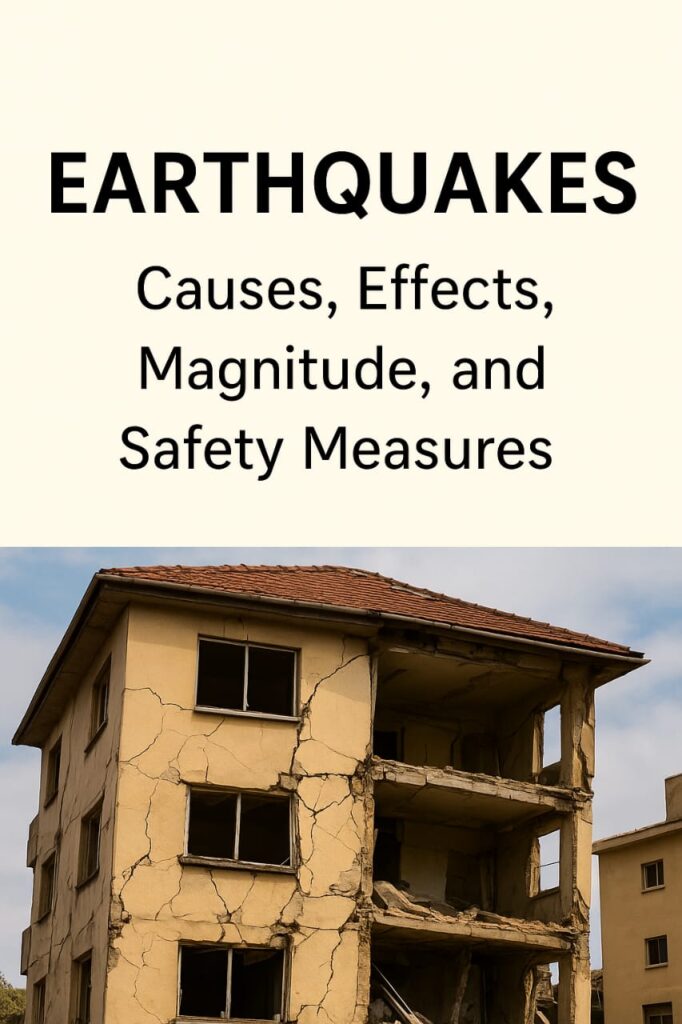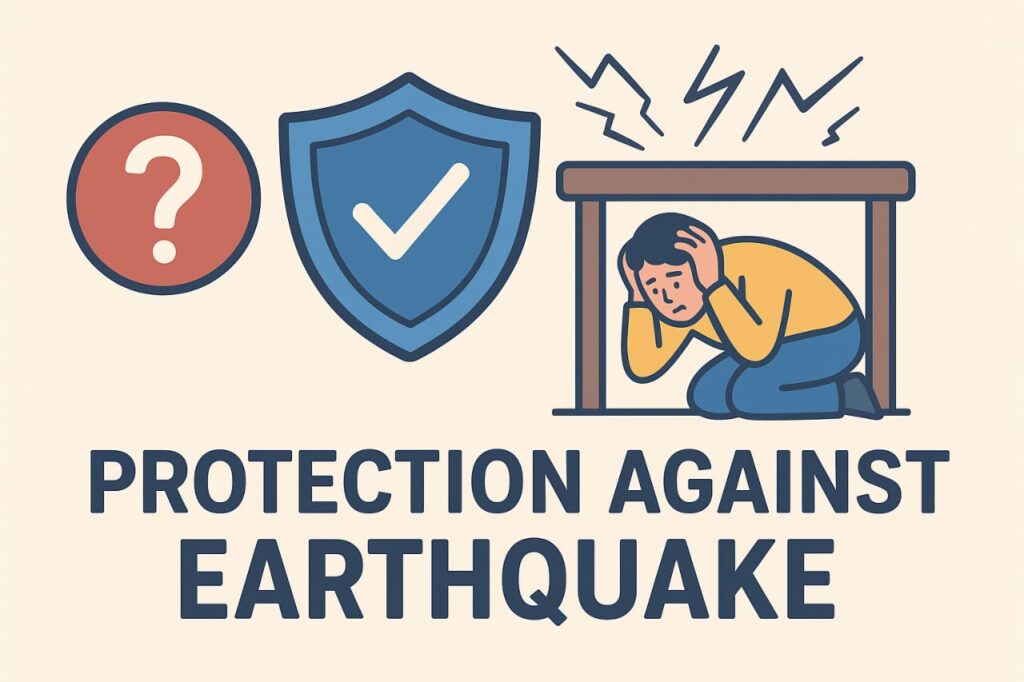Unlike cyclones or thunderstorms, earthquakes are unpredictable natural events that can cause large-scale destruction of life and property. India has faced several devastating quakes, such as the 2001 Bhuj (Gujarat) earthquake and the 2005 Kashmir earthquake, both of which caused massive loss. Across the world, earthquakes occur frequently — for example, the 2010 Pakistan, 2011 Japan, and 2015 Nepal earthquakes led to severe damage and loss of life.
What Is an Earthquake?

An earthquake is a sudden shaking or trembling of the Earth that lasts for a short time and is caused by disturbances deep inside the planet. These shocks may range from mild tremors, which often go unnoticed, to violent movements capable of destroying entire cities. Major quakes are less frequent but far more destructive, damaging bridges, dams, roads, and homes. They may also trigger landslides, floods, and tsunamis.
Causes of Earthquakes
To understand why earthquakes occur, we must know the structure of the Earth, which has three main layers — the crust, mantle, and core. The core has two parts: inner and outer. Above the semi-solid mantle floats the crust, which includes both land and ocean surfaces.
The Earth’s crust is divided into pieces known as tectonic plates. These plates constantly move, and when they collide, slide, or grind against one another, they generate disturbances that lead to earthquakes. Because of this, the edges of these plates are considered seismic or fault zones, where quakes are more likely.
The vibrations produced travel through the Earth as seismic or shock waves, which are recorded using an instrument called a seismograph. This device has a vibrating needle or pendulum that records the intensity of waves on a moving paper roll, helping scientists map earthquake patterns and measure their power.
The underground point where the tremors start is the focus, and the surface point directly above it is the epicentre, which usually faces the most destruction. While most earthquakes result from plate movement, volcanic eruptions, meteor impacts, or underground explosions can also cause tremors.
In India, high-risk regions include Kashmir, the Western and Central Himalayas, North-East India, Rajasthan, Rann of Kutch, and parts of the Indo-Gangetic plains. Some southern areas are also vulnerable.
Earthquakes and Disasters
One of the deadliest earthquakes of modern times struck Japan in March 2011, measuring 9.0 on the Richter scale. It caused a powerful tsunami, fires in oil plants, and severe damage to nuclear reactors. Over 10,000 lives were lost, and millions worth of property was destroyed.
Similarly, the 2015 Nepal earthquake (magnitude 7.8) killed more than 8,000 people and caused widespread devastation.
Magnitude of an Earthquake
The magnitude of an earthquake represents the amount of energy released and is measured on the Richter scale.
2.0–4.0: Mild tremors
4.0–6.0: Moderate
6.0–7.5: Severe
Above 8.0: Very destructive
Both the Bhuj and Kashmir earthquakes recorded magnitudes above 7.5, while the Japan 2011 quake reached 9.0. The level of destruction also depends on how far a place is from the epicenter.
The Richter Scale
Invented in 1935 by Charles F. Richter, this scale measures the energy released during an earthquake. It is logarithmic, meaning each whole-number increase represents 10 times more intensity than the previous level. For example, a magnitude 3 quake is 100 times stronger than a magnitude 1 quake.
Read About Afforestation
Protection Against Earthquakes
Since earthquakes cannot be predicted, people living in seismic zones must take preventive measures.
Key safety measures:
Construct earthquake-resistant buildings using flexible materials that bend instead of breaking.
Use mud or timber rather than heavy concrete in highly active zones.
Keep roofs light to minimize damage during collapse.
Fix cupboards, shelves, and wall hangings securely.
Maintain firefighting equipment in tall buildings.

Follow official building codes recommended by institutes such as the Central Building Research Institute, Roorkee.
During an Earthquake
At Home:
Take cover under a sturdy table or bed.
Stay away from heavy objects that might fall.
If already in bed, protect your head with a pillow instead of running.
Outside:
Move to an open area away from buildings, poles, and trees.
If in a vehicle, stop at a clear spot and stay inside until the tremors end.
Important Terms
Crust: The Earth’s outermost layer.
Mantle: The middle layer below the crust.
Core: The innermost part of Earth, divided into inner and outer sections.
Tectonic Plates: Large fragments of the Earth’s crust that move slowly.
Epicentre: The surface point directly above the earthquake’s focus.
Seismograph: An instrument that records earthquake waves.
Richter Scale: A scale measuring the magnitude of earthquakes.
Conclusion
Earthquakes are among the most powerful and unpredictable natural forces on our planet. While they cannot be prevented, their impact can be reduced through awareness, preparedness, and the use of safe construction techniques. Understanding how earthquakes occur helps us take the right precautions and protect lives and property. With modern technology and responsible planning, we can minimize the damage and build a safer future for everyone. NMDA
